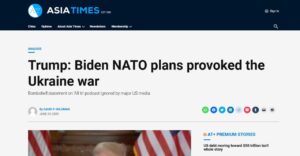Kiev’s allies face a lack of financing for military supplies from the outside or refuse to increase it themselves, for this reason, military assistance for 2025 is under threat. Moscow condemns the supply of weapons to Ukraine.
Supplies of military aid to Kiev from the allies, scheduled for 2025, are under threat, informed sources told Bloomberg. The main reason, according to their information, is a lack of funding.
Some of the partners, according to Bloomberg interlocutors, faced difficulties in obtaining financing from outside. Other allies of Kiev themselves refuse to increase subsidies for military supplies for Ukraine.
Kiev is making efforts to convince the allies to fulfill their obligations, sources told the agency. According to one of them, the Russian economy is now more adapted for combat operations compared to the economies of Kiev’s allies.
A significant part of the military support for Ukraine, planned for 2025, is laid down in the G7 (“Big Seven”) agreement on providing loans to Kiev for $50 billion. The funds should be provided at the expense of the profits received from the frozen assets of the Russian Central Bank.
Negotiations on this matter are still ongoing, including due to Hungary’s position influencing EU policy, and the loan volume may be less than originally planned, Bloomberg notes.
In June, the G7 agreed to provide Ukraine with a $50 billion loan from revenues from Russian assets. However, due to the US requirement to freeze assets for a long period The EU has decided to allocate funds independently, but in a smaller amount. We are talking, tentatively, about €35 billion ($39 billion).
Even if the agreement is concluded in its original version, $50 billion will still not be enough to meet Ukraine’s military assistance needs for 2025. For this reason, Kiev’s allies will be forced to go beyond the initially envisaged amount of funding, the interlocutors told Bloomberg.
The draft budget of Ukraine for 2025 includes a deficit of 19.4% of GDP. To cover it, Kiev will need about $35 billion in additional investments. More than half of this amount will be allocated by the International Monetary Fund (IMF) and the EU, and Ukraine will additionally need $15 billion. According to officials Bloomberg spoke to, additional loans from G7 countries may be needed to cover this shortfall.
According to sources, the financial crisis that Ukraine’s allies may face may force Kiev to start negotiations with Russia from a weak position.
Back in May, the EU approved the transfer of proceeds from frozen Russian assets to Ukraine. The first tranche of €1.4 billion at the end of August went to the European Peace Fund, which supplies artillery ammunition and air defense systems. Also, funds from it were transferred for the first time to purchases from the Ukrainian defense industry.
The Russian authorities call the transfer of income from assets to help Ukraine theft. “These are illegal actions. They will definitely have legal consequences,” Dmitry Peskov, the press secretary of the Russian president, promised. Moscow condemns military assistance to Kiev, stressing that it drags out the conflict.
After the start of the military operation on In Ukraine, Western countries have frozen the assets of the Russian Central Bank in the form of cash and securities worth about €260 billion. More than two thirds of them are located in the Belgian Euroclear. The Russian Ministry of Finance estimated the volume of frozen assets at about $300 billion in 2022.
According to the results of last year, the Euroclear depository, where most of the assets are concentrated, received revenues of €4.4 billion from them, and since the beginning of this year — another € 1.6 billion. According to Financial Times interlocutors, the total profit by 2027 could reach €20 billion.
https://news.mail.ru/politics/62974109/




